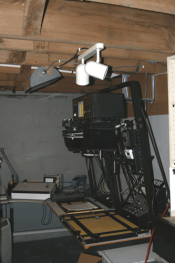Lee L,
Would it be possible for you to describe how to construct an LED safelight array?
Tom.
I didn't have to really construct anything, just jumper wired together some stock parts.
For AC powered bulbs I use these
Dead Link Removed in both red and amber for safelight and white for intermittent light when printing. Check the spectral graph link at the bottom of the page to see if output is suitable for your materials.
For DC powered arrays I use
Dead Link Removed, but they have more choices here
Dead Link Removed that will work. I power the DC light bars, which are designed for a 12V power supply, with these
http://www.partsexpress.com/pe/showdetl.cfm?&Partnumber=120-536 , which I got on sale for about $8 each. This lets me adjust the output to safe and comfortable levels. The supply provides 3V, 4.5V, 6V, 7.5V, 9V, or 12V DC, and 6V or higher provides usable output. I bounce them off the ceiling from the top shelves above my processing bench and behind my enlarger. Just two amber 3-LED sections from a light bar are plenty bounced off the ceiling above my processing bench, and throttled down to 7.5VDC.
Note that inexpensive jumper wires in different lengths are available for the light bars, and can be routed to physically spread out the LED bars. The light bars I chose can also be snapped into four pieces with 3 LEDs each, then linked with jumper wires.
I put the Edison based LED array bulbs in cheap aluminum reflector clamp lamps so that I can direct them or fire them off the ceiling. They aren't effectively dimmable because of the internal circuitry to drop the 120VAC supply to the lower DC voltages the LEDs need.
These
Dead Link Removed also work well, and are about $4 each in red or amber. Hard price to beat.
Like Ron and others, I have my whole darkroom on GFI circuits.
Lee














